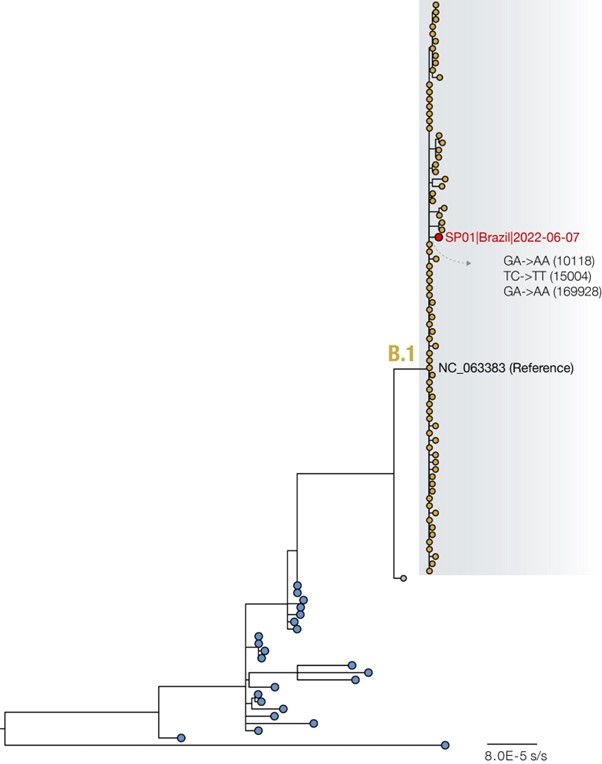Ingra Morales Claro, Ester Sabino and Nuno R. Faria, University of São Paulo, Faculdade de Medicina, Instituto de Medicina Tropical de São Paulo, São Paulo, SP, Brazil.
Researchers from the University of São Paulo (USP, São Paulo, Brazil), the Instituto de Infectologia Emílio Ribas, Secretaria de Estado da Saúde de São Paulo (Brazil), University of Edinburgh, University of Birmingham, Imperial College London, and the University of Oxford, United Kingdom have report a near complete genome of the first confirmed monkeypox case detected in Brazil collected on June 7th, 2022 at Emilio Ribas Institute of Infectious Diseases, from a male patient, aged 41 years old, and with a recent travel history to Portugal and Spain. The article Shotgun metagenomic sequencing of the first monkeypox virus case from Brazil, 2022 was published in the Revista do Instituto de Medicina Tropical de São Paulo, vol. 64.
Monkeypox virus (MPXV) is a zoonotic, double-stranded DNA virus with a 197-kb genome, member of the Orthopoxvirus (OPV) genus and Poxviridae family, which also includes variola virus that causes smallpox. Genomic classification is divided into 2 clades, referred to as the “West African” clade and the “Central African” or “Congo Basin” clade. However, a very recent proposed new classification divided the MPXV into 3 distinct clades (1-3). Clade 3 contains most genomes from the 2017, to 2022 human outbreaks, with its diversity denoted by neutral lineages such as A, to B.1 (Happi et. al, 2022).
MPXV was first identified in a 9-month-old boy in 1970 in the Democratic Republic of Congo, and since then have been responsible for causing several outbreaks of monkeypox reported in the African continent (Bunge et al. 2022). In early May 2022, MPXV cases were detected in the UK and Portugal, most of these with no known travel history to endemic countries.
By June 9th 2022, 1240 cases have been confirmed in 33 countries from all continents, most of them in European countries and the United States, with two MPXV cases from South America, notified from Argentina and 8 suspected monkeypox infections in the States of Santa Catarina, Ceará, Mato Grosso do Sul, Rio Grande do Sul, Rondônia and São Paulo in Brazil.
Figure 1. Maximum likelihood phylogeny with 103 whole genome sequences, including 102 available in NCBI GenBank up to the 9th June 2022. Highlighted genomes (yellow tips), including the SP01 described in this study (red tip), belong to the newly proposed B.1 lineage.
By sequencing through shotgun metagenomic approach, using Nanopore technology the skin swab of the lesions (vesicle and crust) of the suspected case, researchers from the Instituto de Medicina Tropical, São Paulo, Brazil, identified 3 unique SNPs on the first genome MPXV case from Brazil when compared to the updated CDC genome from the USA. They showed that the first MPXV case from Brazil grouped within the newly proposed B.1 lineage (Happi et. al, 2022), and was closely related to sequences from Portugal, Germany, USA, and Spain.
They also evaluated whether recommended diagnostic RT-qPCR primers were suitable for the identification of the newly sequenced virus genome investigating putative mismatches on primers and probes binding sites for both the generic MPXV and the specific B.1 MPXV detection sets. The analysis showed that the found mutations are unlikely to impact the sensitivity of this primer set, indicating that existing primers can detect infections from the current outbreak.
We have now more than 4,000 cases of MPXV confirmed in 47 countries, and Brazil has already reported 14 confirmed cases, three which are autochthones. The authors note that this study highlights the importance of confirming the diagnosis by means of a fast and reliable sequencing technique and the genomic surveillance of MPXV to better understand the epidemiology, transmission patterns, evolution of the virus and its adaptation to human transmission, and continued evaluation of laboratory diagnostic methods.
References
BUNGE, E.M., et al. The changing epidemiology of human monkeypox: a potential threat? A systematic review. PLoS Negl Trop Dis. [online]. 2022, vol. 16, e0010141 [viewed 29 June 2022]. https://doi.org/10.1371/journal.pntd.0010141. Available from: https://journals.plos.org/plosntds/article?id=10.1371/journal.pntd.0010141
HAPPI, C., et al. Urgent need for a non-discriminatory and non-stigmatizing nomenclature for monkeypox virus. Virological.org [online]. [viewed 29 June 2022]. Available from: https://virological.org/t/urgent-need-for-a-non-discriminatory-and-non-stigmatizing-nomenclature-for-monkeypox-virus/853
To read the article, access
CLARO, I.M., et al. Shotgun metagenomic sequencing of the first monkeypox virus case from Brazil, 2022. Rev Inst Med Trop S. Paulo [online]. 2022, vol. 64, e48 [viewed 29 June 2022]. https://doi.org/10.1590/S1678-9946202264048. Available from: https://www.scielo.br/j/rimtsp/a/4K5czBsGKDtzbCS6wDhKLSj/?lang=en
External link
Revista do Instituto de Medicina Tropical de São Paulo – RIMTSP: https://www.scielo.br/j/rimtsp/
Como citar este post [ISO 690/2010]:




















Recent Comments